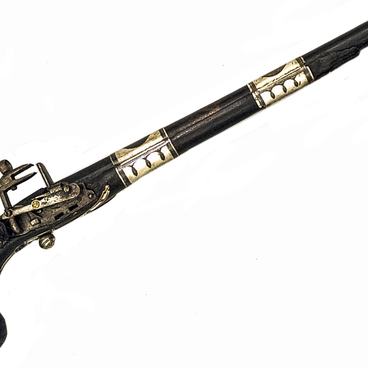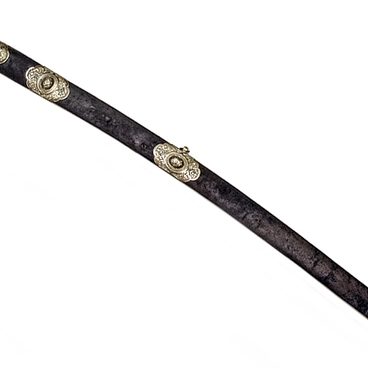Firearms began to be spread in the Caucasus around 16th -17th centuries. The first rifles that began to be widely used at that time were matchlock rifles. Their charges were hand-ignited with a special rod for which purpose the rifle had to be held with one hand. Such firearms were very inconvenient to fire from, therefore in the 18th century they were replaced with flintlock rifles which were supplied to the Caucasus from Turkey.
Flintlock Rifle
Время создания
Middle of the 19th century.
Техника
Wood, iron, steel, silver, gold inlay. Forging, casting, smithing, engraving.
8
Открыть в приложении#1
Flintlock Rifle
#4
#2
Gunsmiths put pieces of flint sharpened from one edge into the triggers of such arms, and when hitting the frizzen – a rifled steel board – the mineral made a spark, which, in turn, ignited the powder charge. It was much simpler to use flintlock rifles than matchlock ones: the trigger did not have to be kept in the cocked position all the time. Hunters could be sure they would not frighten away the prey by glow or smoke typical of the past generation firearms.
#6
In the 18th century, Adyghe gunsmiths organised local manufacturing of rifles using Turkish rifles as an example. Every Circassian village had at least one gunsmith, more often several. Typically, they worked slowly but very artfully giving a lot of attention to the very minute details. Therefore their flintlock rifles, when properly taken care of, could dutifully serve up to a hundred years.
#7
The specific feature of Circassian rifle locks was compact arrangement of large parts.
#8
Barrels were most often rifled: the rifling of the grooves ensured a more accurate shell trajectory and range. Barrels could be round or faceted; the custom was to decorate them with inlay.
#9
The stock of Caucasian rifles was elongated and slim graduating to a bone heel.
#10
Rifles had decorative plates on them with engraved ornaments – floriated, ethnic, or geometric.
#12
Adyghes kept their rifles in special rifle boots, dokhutey. They were made of felt, or goat or badge skins, the latter were especially valuable. The rifle was worn booted and belted behind the back.
Apart from the boot, firearms came complete with some other special accessories, in particular, devices for carrying powder. Adyghes used their customary gazyrs – cartridges that were sewn on a cherkesska (coat), and gynylye (powder flasks).
Apart from the boot, firearms came complete with some other special accessories, in particular, devices for carrying powder. Adyghes used their customary gazyrs – cartridges that were sewn on a cherkesska (coat), and gynylye (powder flasks).
читать дальшескрыть
00:00
00:00
1x
Flintlock Rifle
Время создания
Middle of the 19th century.
Техника
Wood, iron, steel, silver, gold inlay. Forging, casting, smithing, engraving.
8
Открыть в приложении
Поделиться

